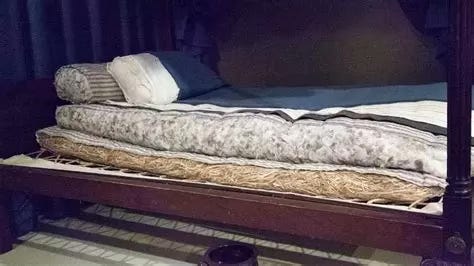In the course of my research into Tudor England, one subject that was of great importance to everyone was where they lay their heads at night and as someone who loves their sleep, I have to agree on the importance of beds.
The historical information I have on Tudor beds comes from the work of the highly knowledgeable and entertaining Ruth Goodman and her book ‘How To Be A Tudor’. Once I have looked at how beds were made during this time, I will then go on in the second half of the post, to look at the folklore and stories associated with them.
For the Tudors a bed referred to a mattress and the frame was a bedstead. If you had both you were clearly well off. Beds were often left in wills, such was their worth, and they could be made of many different materials from humble straw to luxurious eider down.

Those with no bed slept under a blanket on the floor and the floor would be covered with a thick layer of rushes that were changed every 6 months to a year.
If you had a decent sack to stuff then you may choose straw or hay and barely straw which was a little softer. Lady’s bedstraw was the crème de la crème of straw beds offering the smell of fresh mown grass and superior softness. By the 16th century raised bed frames were achievable for many and rushes laid out on a raised bedstead with a straw bed laid on top became the fashion.
If you had access to fleece then a flock bed would have made a very nice upgrade but this needed some stitching skills in order to prevent the wool from bunching up and becoming lumpy.
At the top of the pecking order (no pun intended) were feather beds, made from tightly woven material and fluffy down feathers, the best of which were eider down.
The result? If you had access to all these resources you may be lucky enough to have several beds that could be layered on a frame to give you a very comfortable night’s sleep.
The aristocracy would likely have four posts and a headboard on the bedstead, allowing for a curtain to be hung around it. A tester bed also had a cloth or wooden ceiling. The most ideal situation to keep out the drafts would be a frame with posts, a wooden top, curtains gathered at the bottom and then layers of beds that consisted of a rush mat, straw bed of lady’s bedstraw, a flock bed and up to two feather beds. As Ruth Goodman puts it in her book:
‘a bed so soft, warm and comfortable that even a princess should not feel a pea buried down at the bottom’ – p11
So what of the folklore and stories of beds?
Keep reading with a 7-day free trial
Subscribe to Cerridwen's Cauldron to keep reading this post and get 7 days of free access to the full post archives.




